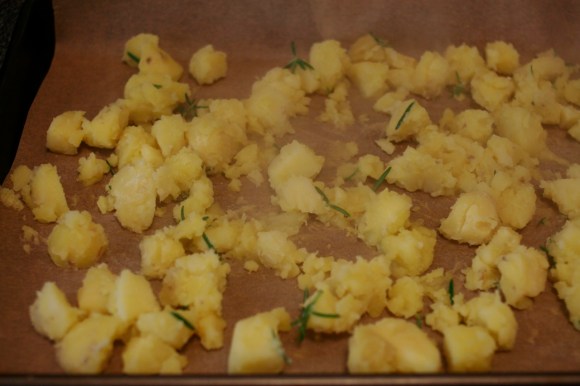We’ve just been looking for excuses to make these rosemary roasted potatoes from the Zuni Cafe Cookbook—and mussels and fries is a pretty classic combination. I made these potatoes for the first time a few weeks ago and they are wonderful. The larger chunks will approximate the best french fries you’ve ever had, the smaller mashed pieces will brown into amazingly crispy potato chips. The best part—you don’t have to stand in front of a vat of fry oil to make them.
Mussels in White Wine and Herb Broth
1 lb mussels, scrubbed with beards removed
1 onion, diced
3 cloves garlic, diced
1 1/2 cups white wine
1/2 cup broth or water
2 sprigs thyme
2 sprigs rosemary
1/2 teaspoon fennel seed
1/2 teaspoon chili flake
salt, pepper, olive oil
In a large stock pot, saute the onion in a little olive oil until translucent. Add the garlic and saute for a few more minutes. Add the white wine, broth and herbs and bring to a simmer. Season with salt and pepper.
When you’ve got about 10 minutes left on the potatoes, add the mussels to the broth. Give it a stir and cover. Stir every few minutes to rotate the mussels. When most of the mussels have opened, they’re done. Pour mussels and broth into a large dish to serve.
Crispy Rosemary Roasted Potatoes, from The Zuni Cafe Cookbook by Judy Rodgers
1 1/2 lbs yellow potatoes, peeled and cut into 1″ chunks
salt
1 – 2 sprigs of fresh rosemary
1/4 cup olive oil
Preheat an oven to 400 degrees.
Peel the potatoes and cut them into rough 1″ chunks. Put them in a large saucepan and cover with cold water. Season the water liberally with salt. When you taste the water, it should be well-seasoned. Bring to a simmer over high heat and cook about 10 minutes, until the potatoes are fork tender. Drain and return to the pot.
Strip the leaves from the rosemary and crush lightly. Add them to the warm potatoes and drizzle with olive oil. Stir to coat. Some of the potato chunks will break apart and some of the smaller pieces will become mashed. This is good news. Pour the potatoes onto a parchment-lined baking sheet and spread into an even layer.
Bake 30 – 35 minutes, until crispy and browned. Toss or flip the potatoes a few times while cooking so they brown evenly. Trust me, this blanche then roast method is worth the extra step.
-Emily















